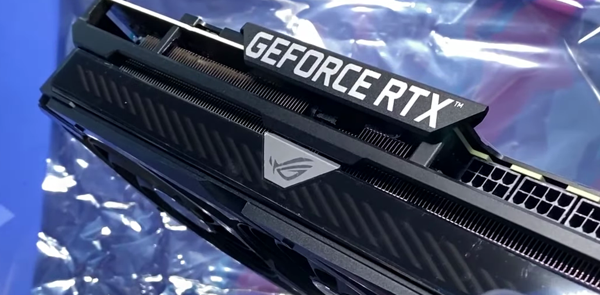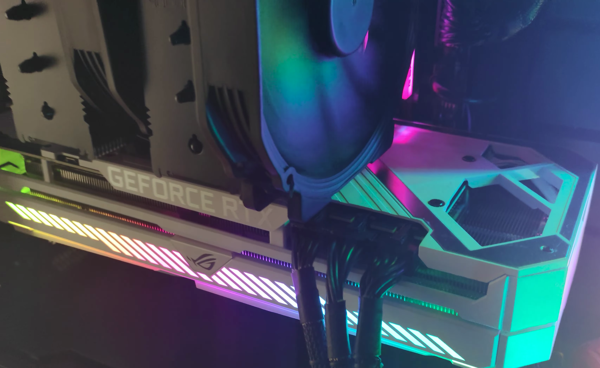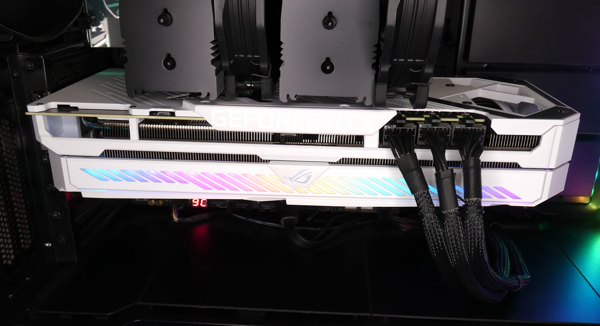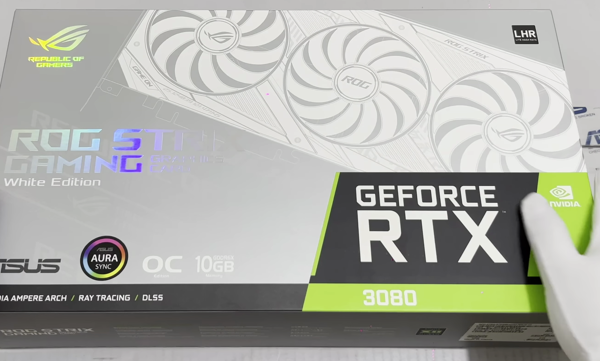Note: As an Amazon Associate we earn from qualifying purchases.
Review: Trying out the ASUS ROG Strix RTX 3080 V2 Gaming GPU (2024)
Introduction
I recently bought the ASUS ROG Strix RTX 3080 V2 White GPU for gaming. It has quite a distinctive white design. I’ve now put it through rigorous testing in various gaming sessions and some video editing - below is my experience with it.
Specifications
| Property | Value | Property | Value |
|---|---|---|---|
| Graphics Coprocessor | NVIDIA GeForce RTX 3080 | Brand | ASUS |
| Graphics Ram Size | 10 GB | GPU Clock Speed | 1935 MHz |
| Video Output Interface | DisplayPort, HDMI |
Photos
Click on photos to enlarge them:
Prices
Check prices of the ASUS ROG Strix RTX 3080 White on:
Initial Impressions of Aesthetics
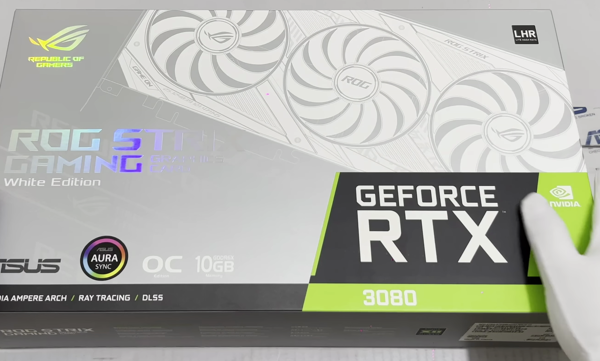
The ASUS ROG Strix RTX 3080 V2 White GPU immediately caught my attention with its stunning all-white colorway. This is a big deal for someone keen on color-coordinating their gaming rig; it’s the perfect match for a high-end setup that values aesthetics as much as performance. The white theme of this GPU creates a sleek, modern look that stands out, especially if you have a case with a transparent side panel.
Let’s talk about its key aesthetic features:
Completely White Colorway: The classic ROG Strix design has been executed in a new, white finish, which is rare and highly sought after.
Cooling Fans and Shroud: The cooling solution doesn’t just function efficiently; it looks impressive too, with the distinctive ROG aesthetic, now in white.
RGB Lighting: This feature complements the white design beautifully, offering a stylish accent that can be customized to suit any mood or build theme.
However, while the design is beautiful, it’s not necessarily for everyone, and it does come with a few trade-offs. The white color can be somewhat high maintenance, potentially showing dust and fingerprints more than darker cards. If you’re someone who likes their setup to look pristine at all times, you might find yourself cleaning the card more often than you’d like.
The excitement around this card is palpable when you consider the attention to detail. Labels, ports, and even screws have been color-matched to maintain the seamless white theme. The ROG Strix GeForce RTX 3080 doesn’t just aim to fit into a white-themed build; it aims to be the centerpiece.
Beware though, the unique colorway does come with a potentially higher price tag, and that’s something to keep in mind if budget is a concern. However, if you’re after a card that makes as much of a visual impact as a performance one, the extra investment might seem justifiable. The limited edition nature of this GPU means it carries an exclusivity factor, something that might be important for collectors or gaming enthusiasts who take pride in owning rare items.
While I can’t help but praise its appearance, I also acknowledge that the appearance does not change the actual performance of the card. That is why this section is dedicated solely to the aesthetics – and in this regard, the ASUS ROG Strix RTX 3080 V2 White GPU really does hit the mark for those who value the visual elements of their gaming setups.
Deep Dive into Performance

Navigating the world of gaming graphics cards can be both exciting and challenging, especially with options like the ASUS ROG Strix RTX 3080 V2 White GPU. As a gaming enthusiast, upgrading my rig with a GPU that isn’t just about looks but delivers on performance was my top priority. After some testing, here’s what I found with this particular model:
Performance Highlights:
Memory Speed: With a 19 Gbps clock rate and a sizable 10 GB of graphics RAM, this card is more than equipped to handle modern gaming titles at high resolutions.
Digital Max Resolution: The ability to support a digital max resolution of 7680 x 4320 means it’s ready for the future of ultra-high-definition gaming.
NVIDIA Ampere Architecture: The card is built on NVIDIA’s latest architecture, which translates into faster and more efficient performance.
Coming from a Founders Edition 3080, my expectations for the ROG Strix were high. The switch promised an experience enhanced by the bells and whistles that accompany a high-end card like this one. Initially, I was struck by the peak GPU clock speed of 1935 MHz and the impressive video output interfaces, which include both DisplayPort and HDMI. This indicates flexibility and power in terms of connectivity and display performance—a win for those pushing multiple high-refresh-rate monitors.
This card’s AI-enhanced graphics are thanks to the 3rd Generation Tensor Cores, an upgrade that promises to keep frame rates high and gameplay smooth even when pushing the boundaries of in-game settings. Moreover, when I discovered it had Lite Hash Rate (LHR), making it less efficient for mining, I was content knowing I’d use it only for gaming rather than cryptocurrency mining.
However, like any piece of technology, it isn’t without its drawbacks. While it boasts doubled throughput on second-generation RT Cores, which enhances ray tracing, I’ve noted an increase in memory temperatures over time. The estimated 43 MH/s ETH hash rate may appeal to some, but as for gaming, there is a slight concern about long-term durability given my experiences with stability.
One of my primary ambitions with this GPU was to leverage its potential for my white-themed setup. While aesthetics were covered in another section, it’s worth mentioning that performance-wise, the design did not compromise airflow or cooling, a critical aspect of sustained performance under load.
My Takeaway:
Pros:
Superb memory speed and resolution support.
Advanced NVIDIA features like Ampere SM and Tensor Cores.
Versatile connectivity options. Cons:
Memory temps can surge under heavy load.
Potential stability issues, as noticed with long gaming sessions.
In short, the ASUS ROG Strix RTX 3080 V2 White performs magnificently for gaming, and its build follows through on most of its promises. Nevertheless, users should be cognizant of potential heat-related issues and stability which might emerge over time. Despite these concerns, for those seeking top-tier performance aligned with a specific build aesthetic, this card is an undeniably powerful addition.
Stability and Temperature Concerns

The ASUS ROG Strix RTX 3080 V2 White GPU comes with high expectations, primarily due to its stunning white colorway that makes it a centerpiece for any gaming rig. It certainly has the looks to kill, but in a card of this caliber, we also look for uncompromising performance and reliability.
My experience with the card reveals a few points of concern that potential buyers should be aware of, which I’ve summarized here:
Stability Issues: Although the Strix boasts superior cooling and build quality, I’ve noticed occasional crashes during peak loads. This instability can be a deal-breaker, especially when compared to the Founders Edition that showed rock-solid performance under similar conditions.
Temperature Regulation: Memory temperatures started off reasonable, but with continued intense usage, I’ve seen them creep up alarmingly high. Even with aggressive fan settings, hitting 100°C on the memory chips is a red flag.
Fan Noise: On the positive side, the fan noise is significantly lower than the Founders Edition. It manages to keep things relatively quiet even when the fans are dialed up to counteract the high temperatures.
I’ve also conducted some mining to test the GPU’s capabilities, and while the fans have remained at a lower noise level, the temperature concerns cannot be ignored. My fears were initially allayed by the ASUS reputation for quality, but the seemingly compromised thermal performance leaves me with mixed feelings.
Looking further into stability, I consider that my case might not be isolated. While the out-of-box experience was smooth, the longer-term challenges hint at potential quality control issues. It’s quite plausible that I may have lost out on the ‘silicon lottery’ with a unit that just doesn’t meet the standard expected of the ASUS ROG Strix line.
From a user standpoint, these technical shortcomings are a cause for concern. When I shell out a significant premium for a special edition GPU, I expect it to outperform or, at the very least, match its mainstream counterparts in every aspect, including temperature management and system stability.
The intriguing white aesthetic has indeed made this GPU an attractive acquisition. It’s a pleasure to see it every time I look through my case window. Nevertheless, I can’t help but feel a twinge of disappointment when considering the underlying functional issues. Aesthetics shouldn’t come at the cost of performance and stability, aspects that are at the heart of any serious builder’s concern.
Ultimately, while the ASUS ROG Strix RTX 3080 V2 White GPU scores high on the visual and acoustic fronts, it’s essential for any prospective buyer to weigh these pros against the possibility of facing thermal and stability challenges.
Pricing versus Value Perception

In the realm of high-performance GPUs, the ASUS ROG Strix RTX 3080 V2 White manages to stand out, not just for its striking color but for its specs as well. Yet, when I consider the pricing versus the actual value, my thoughts are torn. On one hand, there’s the premium feel and the top-notch build quality one expects from the ROG Strix series. On the other, the arguably inflated cost due to the aesthetics raises eyebrows – especially when performance gains over other editions aren’t dramatically different.
The Pros:
Striking white color that fits perfectly in themed builds
Generous 10 GB of RAM and high memory speed of 19 Gbps
Impressive NVIDIA Ampere architecture offering efficient and fast performance
Significant improvements with 2nd Generation RT cores and 3rd Generation Tensor Cores
The Cons:
High price point, particularly for the white colorway, which is more aesthetic than utility
Concerns over long-term stability and heat management
In my experience, the additional cost can be a hard pill to swallow. We’re talking about potentially overpaying by a significant margin just for the sake of a color-coordinated build. For some, the aesthetic pleasure may justify the cost. After all, there’s something undeniably appealing about a pristine white GPU that becomes the centerpiece of a custom rig. Moreover, it’s not all looks – ASUs did incorporate advanced technologies like AI-enhanced graphics and higher power limits, slated to provide superior cooling and performance.
I’ve been particularly impressed by the quiet operation and the boost in visual fidelity the card offers. Games look stellar, and the card executes ray tracing like a champ. It’s when everything works seamlessly, I find the value proposition tilting favorably.
However, I’ve also noticed issues with heat and stability, leading to occasional crashes during heavy use – something one wouldn’t expect from a card at such a price range. The sheer fact that the card may not consistently outperform its less expensive counterparts, specifically the Founders Edition, in terms of stability, makes me question its longevity and overall value.
Ultimately, the ROG Strix GeForce RTX 3080 does deliver fantastic performance wrapped in a gorgeous white shell. But when it comes down to pure value – the balance between cost and reliable, long-lasting performance – I can’t fully ignore the drawbacks. It’s an excellent choice for enthusiasts who prioritize aesthetics and are willing to pay the premium. Yet, savvy consumers focused on practicality might not find the price-to-performance ratio compelling enough, given the availability of less expensive yet still formidably equipped options.
